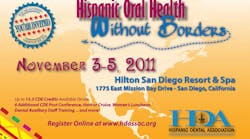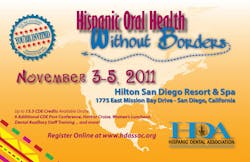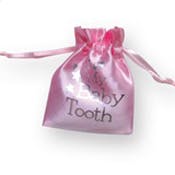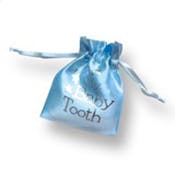American Dental Association’s (ADA) 152nd Annual Session and World Marketplace Exhibition was held Oct. 10-13 at the Mandalay Bay Convention Center in Las Vegas, Nev. While there where many courses and exhibits, I will only highlight a few here.The American Dental Association released the second in a series of papers that examine the challenges and solutions to bringing good oral health to millions of Americans, including the growing population whose only possible source of dental care is the so-called oral health safety net. "Breaking Down Barriers to Oral Health for All Americans: Repairing the Tattered Safety Net" emphasizes the absence of a coordinated, systematic approach to treating underserved populations. It identifies common sense remedies that can greatly improve safety net programs, even absent the major funding increases that are unlikely to occur in the current economic climate. A PDF of "Breaking Down Barriers to Oral Health for All Americans: Repairing the Tattered Safety Net" is available at www.ada.org/sections/advocacy/pdfs/breaking-down-barriers.pdf. The ADA released the first in a series of papers examining the challenges and solutions to bringing good oral health to the millions of Americans-including as many as one-quarter of the nation's children who lack access to dental care. Many of them suffer with untreated disease. The paper focuses on workforce, an umbrella term for the numbers, location, and makeup of the teams comprising dentists, dental hygienists, dental assistants, and other existing and proposed providers. The paper disputes the future shortage of dentists, projecting that later-than-predicted retirement, increased numbers of dental school applicants, and the opening of new dental schools will provide an adequate number of dentists through 2030. The paper cautions against a rush to create so-called "midlevel" dental providers. Whether you agree with the premises in the paper, or not, it is an interesting read! "Breaking Down Barriers to Oral Health for All Americans: The Role of Workforce" is available at www.ada.org/sections/advocacy/pdfs/ada_workforce_statement.pdf.
Hispanic Dental Association (HDA)
The HDA is unveiling a smartphone app at its 2011 HDA 19th Annual Meeting November 3-5, 2011, in San Diego, Calif. For Hispanic oral health data, visit www.hdassoc.org/site/epage/78844_351.htm.
The IHS Division of Oral Health was present at the ADA meeting www.ihs.gov/MedicalPrograms/Dental/index.cfm. Positions may be available at the IHS locations throughout the country. When you begin your Indian Health Service career through the federal Civil Service personnel system, you will have the opportunity to serve appreciative patients and advance your career without making a multi-year commitment to IHS. Flexibility and negotiable starting pay, along with the generous benefits available to federal employees, make Civil Service an attractive choice for experienced dental professionals and recent graduates alike. Many individuals choose to enter the Indian Health Service as a Commissioned Officer of the U.S. Public Health Service (USPHS). Although it is one of the seven uniformed services of the United States Government, USPHS is not a military service. However, working for IHS in this capacity does require a commitment to a minimum of two years. Some dentists, dental hygienists and dental assistants find working directly for a tribe the most rewarding career path. The Indian Health Service (IHS) supports tribal hiring initiatives by including information on the Web site and in recruitment materials. For vacancies, visit www.ihs.gov/MedicalPrograms/Dental/index.cfm. There is a Culture Card available, "A Guide to Build Cultural Awareness American Indian and Alaska Native," at store.samhsa.gov/shin/content//SMA08-4354/SMA08-4354.pdf. The purpose of the guide is to provide basic information for federal disaster responders and other service providers who may be deployed or otherwise assigned to provide or coordinate services in American Indian/Alaska Native (AI/AN) communities. Service providers should use this guide to ensure the following Five Elements of Cultural Competence(1) are being addressed: 1. Awareness, acceptance, and valuing of cultural differences; 2. Awareness of one’s own culture and values; 3. Understanding the range of dynamics that result from the interaction between people of different cultures; 4. Developing cultural knowledge of the particular community served or to access cultural brokers who may have that knowledge; and 5. Ability to adapt individual interventions, programs, and policies to fit the cultural context of the individual, family, or community.In the world of adult orthodontics, there is a new myofunctional appliance system. The Myofunctional Research Co. (MRC) has been developing appliances for more than 20 years. The new MYOBRACE for Adults is a series of appliances to treat malocclusion in adults. For more information, visit www.myoresearch.com/cms/index.php.
In the world of local anesthesia, Milestone Scientific’s award-winning STA Single Tooth Anesthesia System unit combines patented, state-of-the-art computer-controlled injection technology with training to achieve more precise injections, improved drug delivery, and materially enhanced patient comfort levels www.milesci.com/dental.html. Another local anesthetic product is Orabloc, a new Articaine in the USA by the Pierrel Group. It features: a rapid onset of anestesia within 1-9 minutes; complete anesthesia lasts about 1 hour for infiltration, up to 2 hours for nerve block; only 10% overage of epinephrine; a 24-month shelf life at room temperature; very low manufacture-related degradation products such as articaine acid and epinephrine sulphonic acid; sodium edentate free, methylparaben free and latex free; and each Orabloc individual cartridge is blister packed for maximum protection during storage and handling www.orabloc.com/fileadmin/documents/orabloc/Brochure-Pierrel-Orabloc_Aug_2011.pdf.I am often asked about volunteer opportunities abroad. Find a Volunteer Opportunity Now! Browse or search more than 100 organizations offering volunteer opportunities around the world. If you are interested in a particular program, or donating equipment, you can contact the program’s sponsor internationalvolunteer.ada.org/.
1. Adapted from Cross, T., Bazron, B., Dennis, K., and Isaacs, M. (1989). Towards A Culturally Competent System of Care Volume I. Washington, D.C.: Georgetown University Child Development Center, CASSP Technical Assistance Center.
Maria Perno Goldie, RDH, MS
To read previous articles in RDH eVillage FOCUS from 2011 written by Maria Perno Goldie, go to articles.














